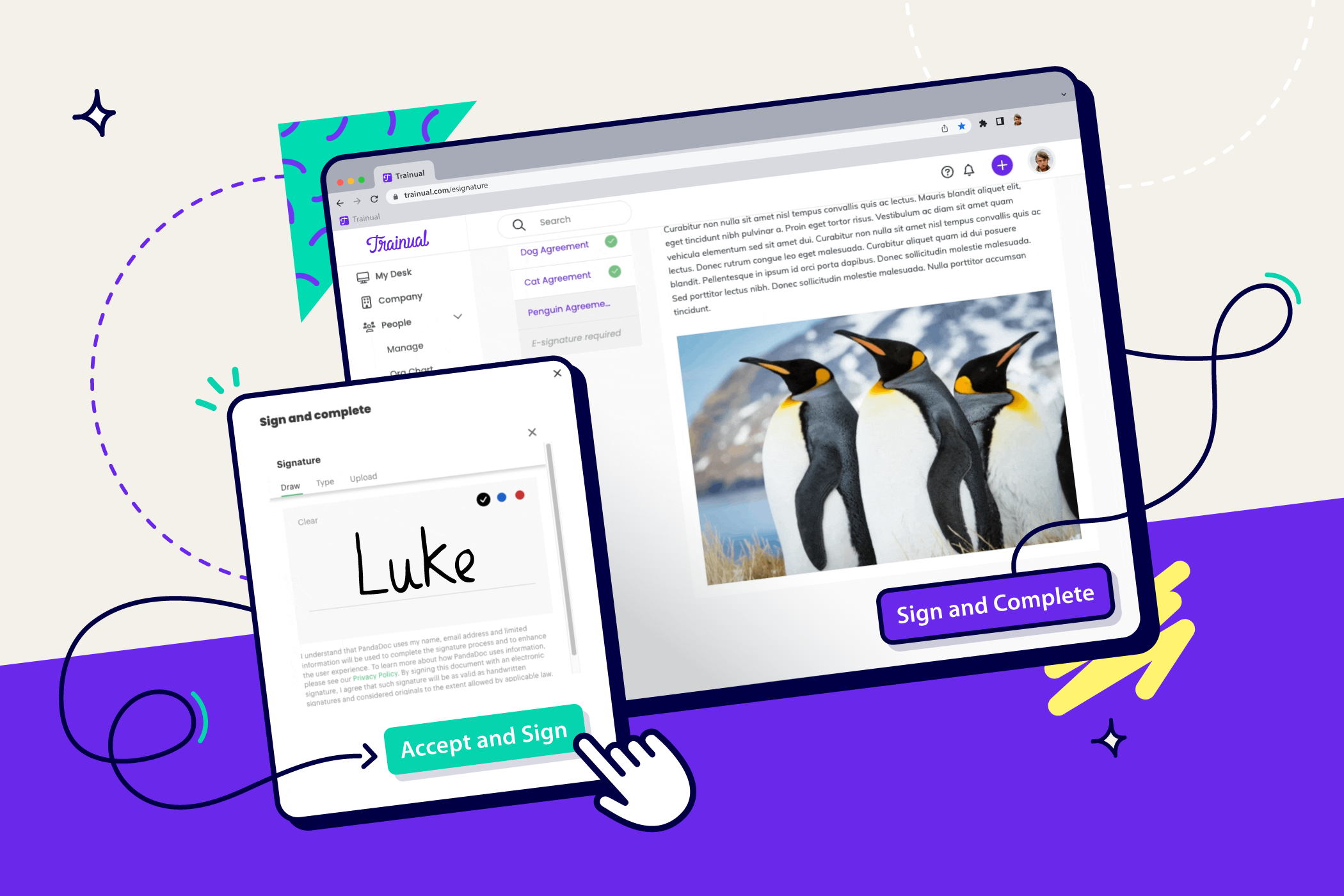
Articles
3 Crucial Digital Tools You’ll Need to Take Your Workforce Remote
October 10, 2022

Not-so-breaking news: The world is going virtual. Once upon a time online shopping was cutting edge. Now, everything from watching movies on demand to doctor's appointments can happen from the comfy cushions of your couch. Truth is, conducting your life in the digital world just isn’t groundbreaking anymore.
In fact, it’s become the norm. And workplaces are starting to follow suit. Naturally, remote (or remote-optimized) work requires remote operations.
If you’ve transitioned to remote operations (or are thinking of reaping the benefits of remote or hybrid work), you’ve probably been left with one big question: What exactly needs to go digital?
Let’s walk through the benefits of going remote and the business operations that will need to go digital if you’re considering a flexible, or fully remote, workforce.
Why go remote
Of course, not all jobs are virtual-appropriate — roles like ER physicians, firefighters, and restaurant wait staff still require that in-person touch (at least until robot servers start taking over).
But realistically, workers can do a bunch of jobs from the comfort of their homes or a coffee shop. In fact, researchers believe nearly 40% of U.S. jobs can be performed 100% at home.
Who’s looking to go remote?
Basically everyone. Nearly 90% of employees want the opportunity to work from home (WFH), and it’s a benefit that would keep 82% of them from quitting. If that doesn’t scream “how to reduce turnover,” we don’t know what does.
An even wilder stat? About three-quarters of workers largely base their decision to take a job on remote flexibility — and over a third have straight-up rejected job offers due to a lack of remote work options. Oof.
Plus, here’s a fun (slash scary) fact: The Gen Z population will make up nearly one-third of the workforce by 2030. And guess what they look for in a potential employer? Wellness and mental health initiatives, a positive culture, and (you guessed it) the flexibility to work from the office or remotely.
So, it’s pretty clear — if you want to lure a huge chunk of the candidate pool to your company (and make them stay), you’ll want to hop on the remote train ASAP.
More importantly, three-quarters of employees who WFH report higher productivity levels. (Don’t quote us, but it’s probably because they don’t get stopped for a way-too-long conversation on their way to the breakroom for lunch. #JustLetMeEat)
Why you need digital tools
Maybe a fully remote team isn’t for your business. But even if you give your team the flexibility to WFH on occasion, you need to equip them with the right digital tools to help them ramp up quickly and work efficiently.
If you haven’t already, it’s time to optimize your operations (AKA get digital) to better support your virtual team and follow the increasingly remote business trends.
Here’s why small businesses are moving to digital tools:
The ROI on software is insane.
Your team needs certain tools to successfully do their jobs — we’re talking training, resources, and equipment. Otherwise, you’re setting them up for failure.
Some tools help managers give their team the resources they need in nearly half the time or help employees work over four times faster. Others answer all their questions — helping them remember how-tos and important need-to-knows right where they’re working.
When you help your team members reach full productivity with digital tools, you can reduce your operating costs by 25% per year. And if you ease day-to-day processes enough to prevent burnout and turnover, you’ll save thousands you’d otherwise have to spend to replace them.
Tech helps you hire and work competitively.
Workers familiar with technology expect to work with digital tools as they’re comfortable learning and working online. So, if you want to attract more candidates, it’s time to show off the tech you leverage to communicate, document, and systemize.
Plus, keeping things up to date has never been easier with digital tools. You can say goodbye to the days of archaic paper and update the tools you use as fast as your business changes. Bonus: your digital documentation can’t get lost (unlike those stained papers laying around that somehow got mistaken for trash).
Let’s break down the top three business operations that need to go digital for your remote workforce.
1. Broaden your candidate pool with digital interviewing.
A recent poll revealed that 44% of businesses start their hiring process with virtual interviewing. Why? When you hire remotely, you get access to talent far and wide — not just in your local area. Say hello to a larger pool of qualified, diverse, and passionate candidates you’d otherwise never get to meet.
While you won’t get face-to-face interaction with an online interview (using a tool like Zoom), you can still get a great feel for your candidate’s interpersonal skills, qualifications, and experiences. Hand-shaking is so pre-COVID.
Just keep in mind that digital hiring doesn’t give you an excuse to be “tougher” on candidates (like nearly 40% of interviewers). After all, your potential new hire doesn’t have any sort of upper hand in your process by sitting in their own desk chair instead of yours.
How to hire remotely
If you choose a remote interviewing process, do your best to help them feel comfortable with icebreakers, smiles, and encouragement during your conversation. You want each interviewee to be their authentic self during your process so you can get to know them and see if they're what you're looking for. This’ll also help them get excited to join your team.
After your digital interview process, feel free to use a digital recording software to send any follow-up video messages. It makes your candidate’s experience so much more personable. We love using Loom for this so that we can make training screen shares with it, too!
🔥 Tip: Add your mission statement, vision, and core values to your digital business playbook. Then, share them with prospective candidates so they can make sure their own beliefs and goals line up with yours. Get started with Trainual.
2. Cut onboarding time in half with online training.
It’s the beginning of your career. You frantically follow people around with a notepad, writing down all the acronyms you don’t know. You leave notes by your computer (or typewriter) because you don’t want to forget anything being hurled at you — and you’re on information overload. Remember those days?
Thankfully, we’re past the sticky note stone age and have the wonderful gift of technology. Today, new hires don’t have to jot down every little thing they learn as they onboard (that is, if you use tech to your advantage).
How online training helps your employees
When you force new hires to sit through snoozy presentations, they’ll end up forgetting 90% of what they learned by the end of the week. (Are you even allowed to call that training?)
Here are the top five reasons you need to switch to online training as of yesterday:
1. New hires ramp up quick AF.
You can get employees up to speed twice as fast with the right online training. Why? When you present new hires with engaging information, they soak it up with 100% of their attention, on their own time. Afterward, they can go back to the training to revisit anything they forgot at any time — no matter how long it’s been since their hire date.
👉 Want to train new hires twice as fast? Use Trainual to build engaging training content that your team can access 24/7 on a desktop or mobile phone. Try for free.
2. The whole team saves time.
Pop quiz! What’s faster? Option 1: Wandering around trying to find an answer to your question. Option 2: Getting an immediate answer to your question. Ding, ding, ding! You got it.
When you can get an immediate answer to your question, you can almost cut your work time in half. (Plus, you’re not wasting anyone else's time to get help.)
We know you love your team. But we also know you don’t love getting asked the same questions over and over. When you put the answer in your online training software, your team can search for their questions there instead of beelining it to you. Brilliant.
3. You can track people’s training progress.
If you hand new hires a paper copy of their training, they could toss it right into the trash and you’d never know. When you assign them training online instead, you can track their training progress as they get ramped up.
4. New hires get confident faster.
As soon as your hire accepts their position, they’re part of the team. And they should be treated like it. They’re officially part of what you’re building, so there’s no need to keep any secret sauce from them.
And when you equip them with the right tools and information, they’ll gain the confidence they need to carry out their responsibilities, collaborate effectively, and meet their goals a lot faster.
5. Training stays up to date.
You may have some binders full of training materials and handouts. While this isn’t a horoscope, we predict that your hard copies will be out of date very soon (if they’re not already).
When you document training online, you can update it in just a few clicks instead of creating and printing a whole new one. Plus, you can alert existing team members of new standard operating procedures as they change with your growing company.
3. Boost accountability with e-signatures on training material.
After you’ve gotten your online training platform all set up to educate and provide 24/7 support to your team, it’s time to make sure you can hold everyone accountable for what they’ve learned and that you’re all on the same page.
Every company has policies. You know, those uber-important rules that keep everyone safe, accountable, and aligned. But can you make sure every team member fully understands and agrees to each one? Our answer: Yup. You just need a certified e-signature tool that’s integrated with your training platform.
Why your training needs a built-in e-signature tool
When your online training software is equipped with e-signatures, you can finally toss out those annoying, outdated employee handbook forms, making your onboarding and training processes way smoother. How?
First, here’s a question: Where do you keep your employees’ signed documents right now? If your answer is something like “In a filing cabinet somewhere in my office,” it’s time to level up. When you go digital, you automatically get confirmation that employees understand and agree to all your important policies. Plus, you can keep track of who’s signed what and download copies of team members’ e-signed documents at any time.
When your training and employee handbook forms are joined together, new hires can agree to all the rules and guidelines at the same time they’re learning them. Let’s say you have a policy that needs to be updated. When you go digital, you can easily edit existing policies and require your whole team to re-sign, acknowledging all the new changes.
How to use e-signatures
You’ll want to require e-signature acknowledgments for all of your important policies and guidelines. Here are some examples:
- Equipment safety policies. Whether your employees regularly use hazardous machinery or sometimes use slightly pointy tools, it’s up to you to make sure they’ve reviewed and understand how to use them safely. And when you require e-signatures to acknowledge safety training, you can be sure your team read (and re-read) them all.
- Field safety protocols. Safety is your number one priority. If you have team members in the field, each one needs to know safety protocols like the back of their hand in case they encounter an aggressive animal, a verbally abusive customer, or any other unsafe scenario. Take no chance that the best course of action is common sense. Instead, spell it out, and get everyone’s agreement in digital writing.
- Non-compete agreements. The last thing you want is for your employee to quit and go start a rival business or work for your number one competitor. Be sure to cover your bases with a non-compete agreement each new hire has to sign as soon as they start their training.
- Non-disclosure agreement. Some of your team members have access to confidential customer information (like SSN, addresses, and emails). Don’t assume that the utmost importance of client confidentiality is a given. Instead, fully articulate your expectations and be sure everyone signs on the (virtual) dotted line.
💥 Breaking news: Your training and new hire forms can finally live in the same place with Trainual’s brand new e-signatures feature. That means it’s time to throw away your outdated paper policies and get documented, digital proof that your team understands and agrees to the policies that keep them safe, accountable, and aligned. Try Trainual for free.
Similar Blog Posts



%20copy.avif)







